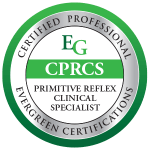I have the expertise to take you where you want to be.
Your health and wellbeing is my priority.
Each Primitive Reflex Integration session may involve the following:

Primitive reflexes are repetitive, automatic movements that provide the foundation for all motor coordination skills and we ALL have them in our early life.
Primitive reflexes are essential during infancy to develop head control, muscle tone, sensory integration and visual development.
Integration of these reflexes is necessary for a child’s development of spontaneous postural movement and proper visual-motor development.
However, these reflexes should not be present past very early childhood.
When they are still present beyond this stage, retained reflexes can act as ‘blockages’ to further development.
The obstacles they create manifest as everything from handwriting difficulty to a lack of balance or ‘clumsiness’.
By taking the “Retained Primitive Reflexes Questionnaire” will help in suggesting the need for a screening for retained primitive reflexes.
Below are the most common retained primitive reflexes and what they are.
The Moro reflex serves as a baby’s primitive fight or flight reaction.
It is usually inhibited by around 4 months of post-natal life and replaced by an adult “startle” reflex.
When the Moro reflex is retained in an older child it becomes an automatic uncontrollable overreaction to any type of stimulus, therefore overriding the higher decision making center of the brain.
Retention of the Moro reflex can present the following challenges: hyperactivity, extreme sensitivity to sudden movement, noise or light, sleeping problems, impulsive behaviours, inappropriate behavioural responses, food sensitivities, emotional and social immaturity, poor adaptation skills.
The ATNR reflex (asymmetrical tonic neck reflex) is activated by turning the head to the left or right side.
As the head is turned, the arm and leg on the same side will extend while the opposite limbs bend.
If not fully integrated, the ATNR reflex can cause difficulties with:
The TLR (tonic labyrinthine reflex) is associated with balance and coordination of the extremities. This reflex is activated by bending the head forward or backwards (head forward – the body and limbs curl inwards, head backwards – the body and torso straighten and extend).
If not fully integrated the alignment of the head with the rest of the body will be uncoordinated.
Proper head and neck alignment is necessary for balance, visual tracking, auditory processing and organised muscle tone, which are all vital to the ability to focus and pay attention.
STNR (symmetrical tonic neck reflex) – The STNR reflex causes the arms to bend and the legs to extend when the head is bent down and causes the opposite – legs bent, arms straight – when the head is bent backwards.
If the STNR reflex remains present in an older child, it can cause difficulty with:
The spinal galant reflex exists to help babies move their hips as they move through the birth canal and is elicited when the side of the lower spine is stroked gently.
If not fully integrated, it can result in difficulties with:
This can cause excessive fidgeting and hip movement while seated in a chair.
The FPR is a withdrawal reflex that emerges in the embryonic stage.
During this stage the embryo reacts to stress and stimulation by withdrawing and freezing.
As the foetus’s tactile awareness develops, withdrawal upon contact gradually lessens.
It is thought that this reflex is the first step in learning to cope with stress.
Ideally, the FPR merges into the Moro reflex and has become inactive before birth.
If the FPR is not fully integrated at birth it may contribute to life-long challenges related to fear.
People with the FPR active may often be very anxious and tend to veer towards negativity which can prevent them from easily moving forward to living a meaningful, interactive life.
An active FPR often goes hand-in-hand with an unintegrated Moro reflex.
The Palmar Reflex a.k.a. Grasp Reflex is seen when an infant grips around an object that touches their palm.
This is normal and helps the baby learn to grip and hang on to things with their hands.
The Palmar Reflex develops in the third month of gestation and should disappear at around 3-6 months of age as they gain hand control.
It is needed for hand-eye coordination, proper vision, and direction/distance judgement.
If it isn’t properly integrated it can contribute to an array of problems.